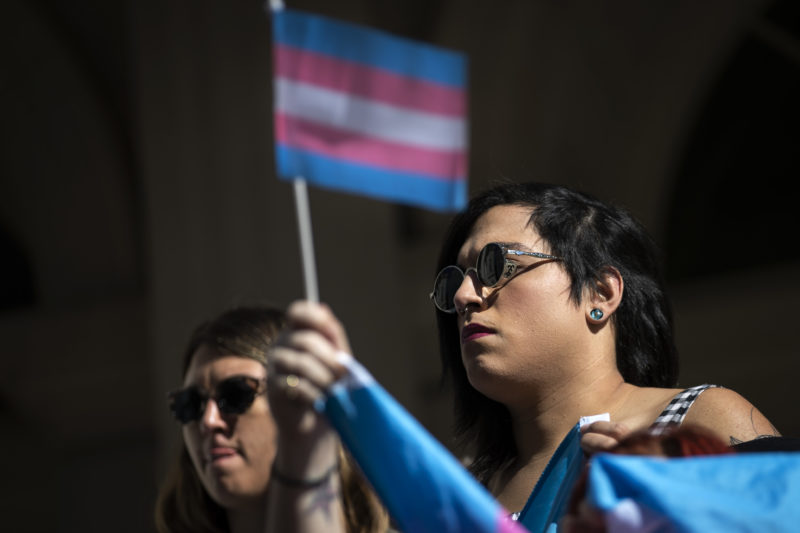New Report Shows the Scope of Anti-Trans Violence in the US
The Human Rights Campaign has tracked 128 transgender victims of fatal violence since January 2013; at least 110 of these were transgender people of color.

Nikki Enriquez wore a glittery, one-sleeved red dress in her casket, matching the one Aretha Franklin wore at her funeral in August. Nikki, who also went by the name Janelle, had told family members she wanted to wear something similar if something happened to her.
A 28-year-old Latina transgender woman, Nikki was shot and killed in Laredo, Texas, on September 15. She was one of four women killed in what officials described as a two-week “serial killing spree” allegedly carried out by a U.S. Border Patrol agent.
Nikki was also one of at least 22 trans people killed so far this year, a group remembered by the Human Rights Campaign (HRC) in its annual report tracking transgender violence and deaths across the United States.
“On Transgender Day of Remembrance, we join together to mourn the lives lost to hate and violence this past year and rededicate ourselves to the urgent action that this epidemic requires,” HRC President Chad Griffin said in a statement. “From anti-trans employment and housing discrimination to systemic racism, we must recognize the intersecting factors that influence, motivate and embolden the violence that plagues so many within the transgender community—particularly Black and Latina transgender women.”
“A National Epidemic: Fatal Anti-Transgender Violence in America in 2018,” released this week, details factors that lead to transgender violence—from identity erasure and denial to anti-transgender stigma and systemic discrimination, especially under an administration that continues to attack and roll back the rights of trans people. This includes news that the Trump administration is exploring a new policy that would narrowly define gender, in a move criticized by health, advocacy, and human rights organizations as “cruel and discriminatory.”
HRC has tracked 128 transgender victims of fatal violence since January 2013; at least 110 of these were transgender people of color. There were 29 known victims of fatal anti-transgender violence in 2017, the highest number since HRC began tracking. Although each case is unique, the epidemic disproportionately affects trans women of color, who make up 80 percent of all anti-transgender homicides, the report notes.
Many of of the victims’ identities were denied by their families, and many were misgendered by police and media. Some were chased down by authorities or killed by a partner, while some were victims of outright hate crimes.
Nikki’s family accepted who she was and honored her last wishes. They have spoken out publicly and described her as a friendly, outgoing person “who would never get mad.” She loved to go to parties and was loved by the local LGBTQ community, according to her profile in the HRC report.
On Tuesday’s Transgender Day of Remembrance, organizations around the country are calling for tolerance and support, recognizing trans resilience, and honoring those who have been killed because of who they are.
There are about 1.4 million transgender adults in the United States, but only 22 percent of people in the United States say they know a transgender person, compared to nearly 90 percent who say they know someone who is lesbian, gay or bisexual, according to the American Civil Liberties Union (ACLU).
Laws are not enough to protect transgender people, said Mara Keisling, executive director of the National Center for Transgender Equality, in an email. The lives lost “deserved a community they could trust, and a society in which they could safely be themselves.”
When people are isolated they will not trust enough to reach out for help. This is true of families and communities that deny support, of police that abuse, and of governments that erase trans identities, she said.
“This failure to protect and serve some of the most vulnerable people in our country today encourages this violence. It provokes this violence. It renders too many transgender people of color invisible, their lives and struggles only noticed once their blood has spilled,” Keisling said. “Today, as we remember those lost to hate and prejudice, we must recommit ourselves to real, lasting, and life-saving change.”
The solution, she said, is to welcome transgender people, hire transgender people, push for policies that keep transgender youth in school, and fight for law enforcement training and policies that ensure trans communities are protected.
“None of us can ignore prejudice and hate without promoting prejudice and hate, therefore it is incumbent on all of us to fight for a better today. We must fight like the lives of transgender people depend on it because the lives of transgender people do depend on it,” Keisling said.

